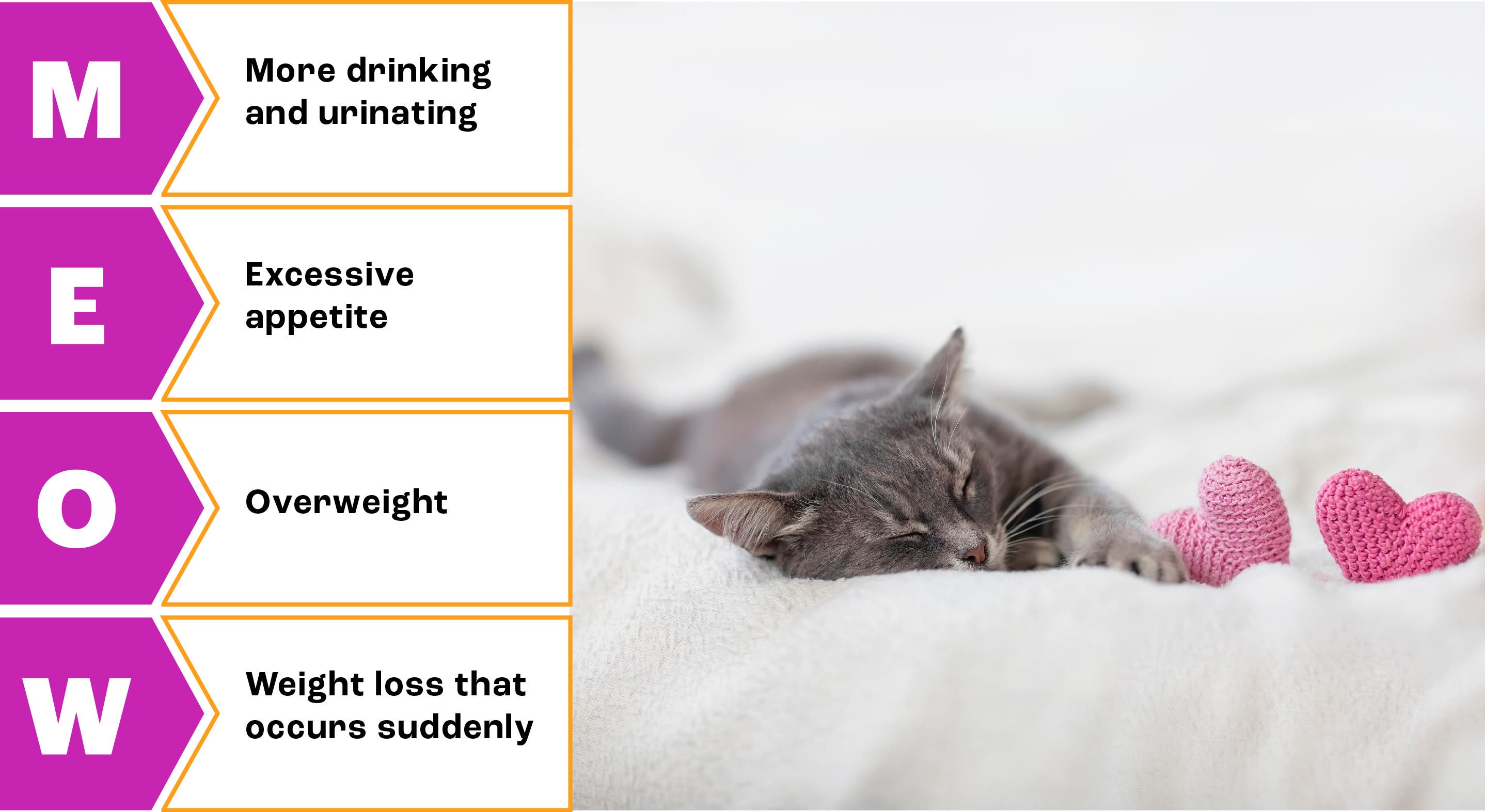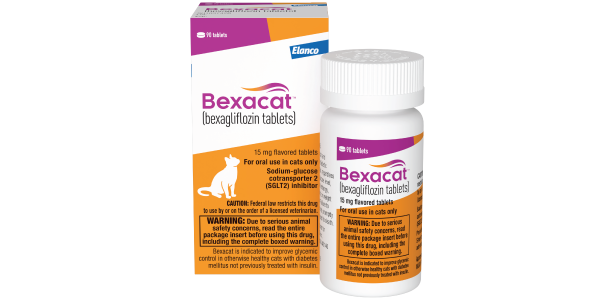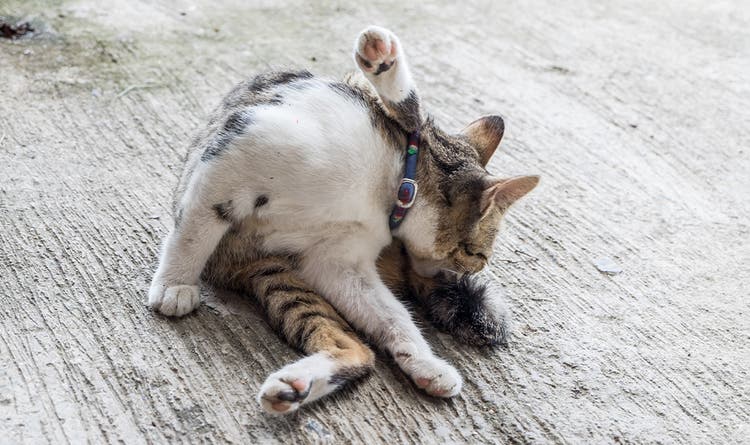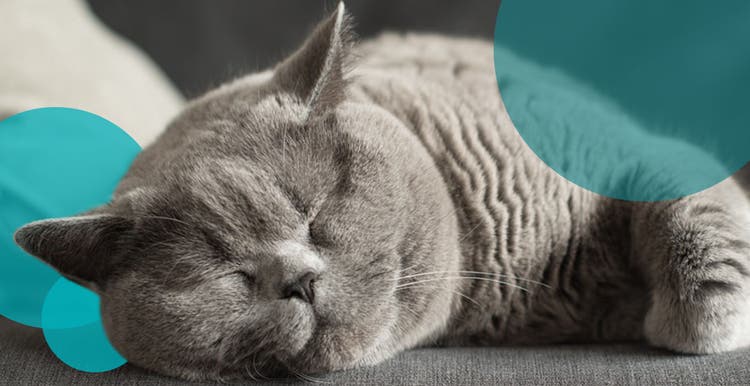Feline diabetes, also known as diabetes mellitus, is a metabolic disease that occurs when a cat's body cannot properly regulate blood glucose (sugar) levels. As with humans’ cells, cats' cells require sugar for energy. However, the body requires insulin, a hormone generated by the pancreas, to carry the sugar from the blood into the cells, providing vital fuel to cells in the muscles, liver, and fat deposits while lowering sugar levels in the blood.
Type I diabetes is characterized by high blood sugar concentrations due to decreased insulin production. On the other hand, Type II diabetes results in elevated sugar levels as the body's cells do not respond suitably to insulin. In both forms of diabetes, cells are unable to access the necessary glucose, despite the presence of ample sugar in the bloodstream, because insulin cannot transfer the sugar to the cells that require it.
Unfortunately, feline diabetes is becoming more prevalent1 and is particularly complications common in older, obese male cats. When left untreated, feline diabetes can cause serious complications, such as kidney disease, nerve damage, blindness and even death. But it is treatable, historically with insulin therapy, just like in humans.
Insulin Therapy
Insulin therapy requires you to monitor your cat’s blood glucose throughout the day to ensure they are at the appropriate level, using a glucose monitor. Then injections are given by the owner once or twice a day depending on glucose levels. It may take time and practice to become comfortable with giving injections to your cat. Moreover, insulin needs to be kept cold which can complicate compliance with this form of treatment.
In fact, 88% of pet owners admit that insulin therapy interferes with their daily routine and 62% find it difficult to administer or have an uncooperative cat.2 As a result, 1 in 10 diabetic pets are euthanized at the time of diagnosis and another 1 in 10 are euthanized within a year of diagnosis due to a lack of success or compliance,which highlights the challenges of treating this disease.3
Prevention is Best, But Not Always Possible
Overweight cats are at a significantly higher risk of developing diabetes. Monitoring their behavior, eating habits, and overall health can help detect diabetes in its early stages, allowing for timely intervention and management. Diabetes is often linked to lifestyle factors, including diet and exercise. Monitoring your cat's weight, food intake, and activity level helps in managing these factors effectively, reducing the risk of diabetes, but if your cat is overweight and tends to lead a sedentary lifestyle, it’s time to start keeping an eye for other possible symptoms of feline diabetes. If you’re unsure what to look for, we have you covered with a simple acronym — M.E.O.W.

“Cats with undiagnosed or untreated diabetes mellitus are at risk for severe consequences that can have profound effects on their health and well-being. As the disease progresses, ongoing damage to the organs of the body can occur. Continued elevation of glucose (sugar) damages cells that produce insulin and may lead to a condition called diabetic ketoacidosis (DKA). Without prompt treatment, DKA is often fatal.”
Cynthia R. Ward, VMD, PhD, DACVIM (SAIM), University of Georgia College of Veterinary Medicine
An Easier Way to Treat Feline Diabetes
BexacatTM (bexagliflozin tablets) is an FDA-approved alternative treatment option for feline diabetes in otherwise healthy cats not previously treated with insulin. It is a simple, flavored tablet that helps control blood sugar levels in cats by increasing the amount of sugar eliminated in the urine. So instead of twice-daily injections, Bexacat is a once-daily tablet that eliminates injections altogether. Although Bexacat has proven effectiveness, as with any medication, there are limitations and possible side effects, which should be discussed with your veterinarian before beginning any treatment. Cats using Bexacat demonstrated decreases in average blood glucose concentration by 67.8% in just 8 hours with minimal risk of hypoglycemia (low blood sugar).2
The advantages of Bexacat become clear when compared to other therapies. No needles, no refrigeration, no mess – just a once-daily, flavored tablet.
References:
- State of Pet Health® 2016 Report. Banfield Pet Hospital. Accessed online at: https://www.banfield.com/en/pet-health/State-of-pet-health.
- Elanco Animal Health. Data on file.
- Niessen S, Hazuchova K, Powney S, et al. The big pet diabetes survey: perceived frequency and triggers for euthanasia. Vet Sci. 2017;4(27):1-13.

Bexacat™ (bexagliflozin tablets)
Before using Bexacat, it is important to read the entire package insert, including the boxed warning. Bexacat is the first needle-free, insulin-free, oral feline diabetes treatment for otherwise healthy cats not previously treated with insulin. If you think your cat may have diabetes, see your veterinarian and ask about once-daily prescription Bexacat tablets.
Indication:
Bexacat is indicated to improve glycemic control in otherwise healthy cats with diabetes mellitus not previously treated with insulin.
Important Safety Information:
Before using Bexacat, you must read the entire package insert, including the boxed warning. Cats treated with Bexacat may be at an increased risk for conditions called diabetic ketoacidosis or euglycemic diabetic ketoacidosis, both of which may result in death. It is critical that cats taking Bexacat be examined by a veterinarian promptly if sudden decreases in appetite or water consumption occur, or if weight loss, tiredness, vomiting, diarrhea, or weakness are seen. Discontinue Bexacat and call your veterinarian immediately if any of these occur as they could be signs of diabetic ketoacidosis or euglycemic diabetic ketoacidosis. Before giving Bexacat, be sure to talk with your veterinarian about any past illnesses your cat has had including if your cat has ever been on insulin, as cats that have been treated with insulin should not receive Bexacat. Do not use Bexacat if your cat has experienced pancreatitis, liver disease or reduced kidney function as serious side effects may occur. Bexacat is available by veterinary prescription only. Not for human use. Keep out of reach of children. Contact a physician immediately if swallowed accidentally.




